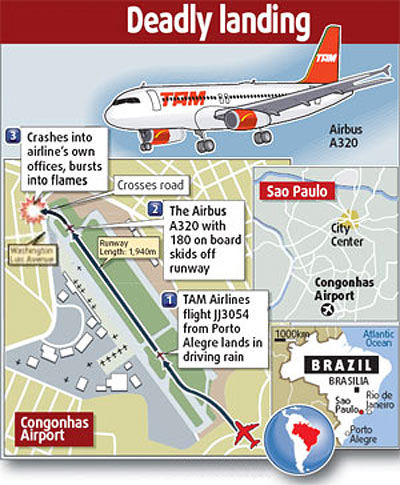| Home / International / International -- News | Tools: Save | Print | E-mail | Most Read |
| 200 Killed After Brazilian Jet Slams into Gas Station |
| Adjust font size: |
Rescue crews pulled about 130 bodies yesterday from an airliner that crashed and burst in flames at a The TAM airlines Airbus-320 was en route to Yesterday, the airline raised the number of people aboard the plane by four to 180 and officials said the chance of finding survivors was near zero.
One hundred and twenty-eight badly charred bodies had been pulled from the wreckage by yesterday, Globo News television reported. President Luiz Inacio Lula da Silva declared three days of national mourning following In September, a Gol Aerolinhas Inteligentes SA Boeing 737 and an executive jet collided over the Amazon rainforest, killing 154 people in what had been the deadliest air disaster in the country. Yesterday, emergency workers recovered the TAM airlines Airbus-320's "black box" flight data recorder, according to the Web site of O Estado de Sao Paulo newspaper. Presidential spokesman Marcelo Baumbach said no cause would be immediately released because it was premature to do so. The runway at The TAM flight was landing on Congonhas' 1,940-meter-long Runway 35, which was recently resurfaced but not grooved, which would provide better breaking in rainy conditions. There were plans to regroove the surface by the end of the month. Because of its short length, Congonhas is known among pilots as the "aircraft carrier". They are instructed to touch down in the first 305 meters of runway, or do a go-around if they overshoot the immediate landing zone.
In The single-aisle, twin-engine plane, delivered in 1998, had logged about 20,000 flight hours in some 9,300 flights, the European planemaker said. More than 3,000 planes from the A320 family have been produced and delivered over the years, Airbus said. The accident happened during heavy rain, and critics have said for years that such an accident was possible at the airport because its runway is too short for large planes landing in rainy weather. In 1996, a Tam airlines Fokker-100 crashed shortly after taking off from Congonhas airport. The crash killed all 96 people on board and three on the ground. A federal court in February of this year briefly banned takeoffs and landings of three types of large jets at the airport because of safety concerns at Congonhas airport, which handles huge volumes of flights for the massive domestic Brazilian air travel market. But an appeals court overruled the ban. ( |
| Tools: Save | Print | E-mail | Most Read |
 |
| Related Stories |
| 40 Remains Found from Brazil Jet Crash |
 |
 |
|
 |
| Links |

